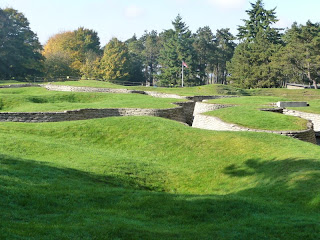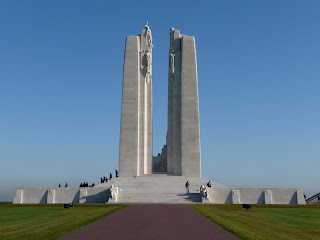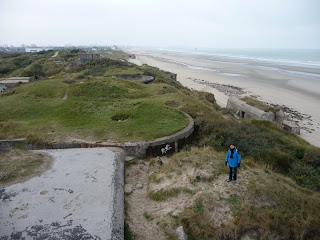
Picture: Ian with the BW trophy after ‘a near run thing’
The Grand Finale pitched the winner of the pre-1811 league (Ian) against the winner of the post-1811 league (Kev) in a final based loosely on Waterloo. Each competitor had ca 85-90 points of POW armies at their disposal, though curiously both armies both had a strength of 326 points.
Ian had drawn the French. Marshal Ney was his commander on the day with Napoleon taking a back seat. In gaming terms Napoleon was a staff officer in charge of the Grande Batterie but also capable of influencing The Guard, (but no-one else!). Ian had taken the option of splitting the Guard into two with Duhesme acting as a Divisional General in charge of the Young Guard.
Kevan had the British and Allies. This was a complicated army with nearly every type of system, infantry type and shooting ability present. Wellington in charge.
There was an off-table ‘race to the battle’ between Grouchy and Blucher. Only one would arrive – not that Ian knew this. Kevan started the game outnumbered but would reach parity once the Prussians arrived. The Prussians would arrive at any time, the later they arrived the more aggressive and more likely to be toward Papelotte and the French line of supply. In gaming terms both players rolled a die with Kevan having a distinct advantage for the first 6 turns. Kevan’s troops also having the better terrain and ensconced in buildings.

Map: Deployment and terrain
The British and Allies had to deploy behind the red line. A Dutch Division had to deploy on Hill 2 in plain view. Kevan had the option to deploy up to a division in Hougoumont and one brigade in La Haye Saint (LHS). All the allies were on hold orders except one division. Kevan had the Union Brigade, a Dutch Division, the Guards, and the 2nd and 3rd Divisions. Kevan placed the 2nd and 3rd on the ridgeline with 2 brigades in reserve. The guards were in Hougoumont and the Union brigade between LHS and Hougoumont on engage orders. Kevan was forced to allocate VPs to the enemy LoS, Papelotte, and hills 3 and 4.
The French had to deploy behind the blue line, but were restricted to the central 4ft. Ian had three infantry divisions, a lancer division, a dragoon division, a cuirassier division, the Guard and a grand battery. The Cuirassier Division had to be on hold orders on their LoS. The French had to allocate VPs to LHS, Hougoumont, and Hill 3, and optionally hills 4 and 2.
The French opened the battle by sending all three infantry divisions and GB through the centre and the two cavalry divisions on a right hook.
Somewhat surprisingly to all concerned ( a 10 on a D10!) the Prussians arrived on turn 1.
(Behind the red line to engage to the British line)
The French Cv destroyed some German conscripts and broke through the very thin ‘red’ line. The recently arrived Prussians then dealt a severe blow to the two French Cv Divisions. The Dragoons scattered but one of the squadrons of Lancers escaping the carnage. However despite their ‘free rein’ elected not to capture Brussels (-50VPs!!!) but preferred to attack the British on hills 3 and 4.
The rest of the battle was mainly a tussle between besieged British and Allies on the ridge from assaults on all sides from the French. La Haye Saint was soon lost. The British and Hanoverians dealing out as best they could but the fire from the grande batterie was devastating: on one turn Ian was rolling on 150pts of damage!! – he rolled a 6 – ha ha ha! (4 points of damage to Ian, 8 to the enemy)
The Union brigade had surprising success against the Cuirassier division eventually scattering it and capturing the enemy line of supply.
At the end of the game hills 3 and 4 were bitterly contested. Hougoumont was still in British hands, La Haye Saint in French hands, and the Union Brigade were on the way to Paris.
Each competitor had been forced to allocate Victory Points to features on the battlefield.

Picture: The situation on the ridge and Ian trying to hide the British Cavalry on his LoS.
Kevan had lost 28% of his army, Ian 25%. The result of the battle depended upon Victory Points. Ian had strategically ignored Hougoumont (-10 VPs) but had captured LHS (+10 VPs) and contested Hill 3 scoring +15 points but lost his LoS (-15) giving a total of 75pts.
Kevan had placed most of his hopes on holding hills 3+4, which he disputed but could claim no points for. He had been forced to put 5 points on Papelotte which he did not capture, and 5 points on the enemy LoS which, surprisingly, he did capture. This gave Kevan a total of 72pts.
Ian, and the French won Waterloo!!
But surely 75 to 72 is ‘a near run thing’.
Thanks to everyone involved in the competition; Chris, Conor, Kevin, Peter, and Ryan.
Seán Slater
PS A difference of 3pts is usually a draw, but this is the finale!! Next year more competitors please!











 After calling in at the Passendale memorial museum (in Zonnebeke) and the local chocolate factory(!), we then called in at Hooge crater. This little private museum (opposite the cemetery), has a very extensive collection of WW1 items and equipment (but just don’t visit on a day with ‘museum fatigue’!). About a 100 yards up the road, is the actual site of Hooge Crater, now a muddy pool in the grounds of a hotel. At the far side of the crater (lake), there are some recreated trenches, Sadly these were flooded, but perhaps gave more of an idea of the famous Passendale mud!?
After calling in at the Passendale memorial museum (in Zonnebeke) and the local chocolate factory(!), we then called in at Hooge crater. This little private museum (opposite the cemetery), has a very extensive collection of WW1 items and equipment (but just don’t visit on a day with ‘museum fatigue’!). About a 100 yards up the road, is the actual site of Hooge Crater, now a muddy pool in the grounds of a hotel. At the far side of the crater (lake), there are some recreated trenches, Sadly these were flooded, but perhaps gave more of an idea of the famous Passendale mud!? Phil T
Phil T